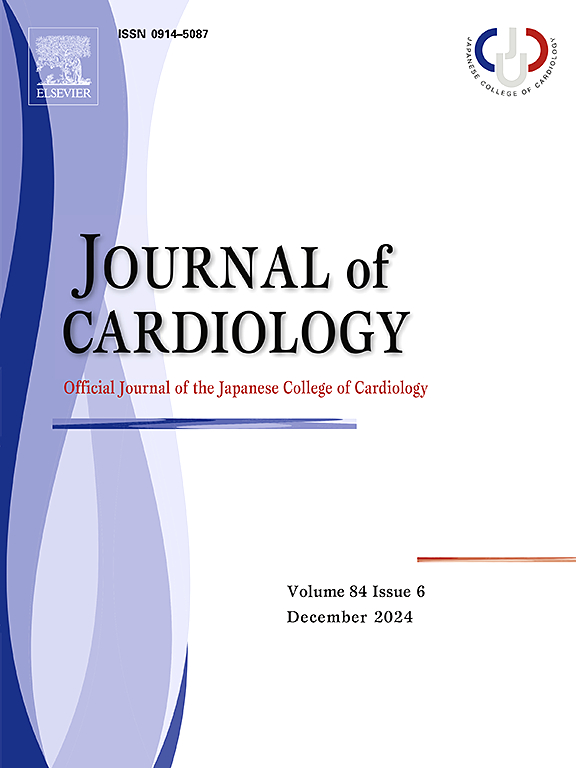Association of door-to-balloon time and one-year outcomes in hospital survivors of ST-elevation myocardial infarction
IF 2.6
3区 医学
Q2 CARDIAC & CARDIOVASCULAR SYSTEMS
引用次数: 0
Abstract
In this study of 19,824 ST-elevated myocardial infarction (STEMI) patients from the J-PCI OUTCOME registry (January 1, 2017, to December 31, 2018), we investigated the association between door-to-balloon time (DTB) and 1-year post-discharge cardiovascular outcomes. Patients with DTB >90 min were older and had higher comorbidities. The incidence of 1-year major adverse cardiovascular events (MACE) showed an incremental increase: 3.7 %, 4.8 %, and 7.7 % for DTB ≤60, DTB 60–90, and DTB >90 groups, respectively. Adjusted hazard ratios (aHR) compared to the DTB 60–90 group were 0.83 (DTB ≤60, p = 0.03) and 1.25 (DTB >90, p = 0.005). Subgroup analysis revealed higher risk for MACE in DTB >90 group for patients aged <70, men, no history of coronary revascularization, and those with cardiac arrest or cardiogenic shock. Conversely, DTB ≤60 group without previous history had a lower MACE risk (aHR 0.80, p = 0.02). This study, the largest of its kind, demonstrates that a DTB below 90 min is associated with lower 1-year MACE risk, supporting current guidelines, and indicating additional benefits for specific patient subgroups, especially those experiencing their first acute coronary event. The findings suggest the importance of early intervention in primary prevention and emphasize the need for prompt detection of vulnerable plaque.

ST段抬高型心肌梗死住院幸存者的 "门到气球时间 "与一年预后的关系。
在这项针对19824名ST段抬高心肌梗死(STEMI)患者的研究中,我们调查了JPCI OUTCOME登记(2017年1月1日至2018年12月31日)中门到气球时间(DTB)与出院后1年心血管预后之间的关系。DTB>90分钟的患者年龄较大,合并症较多。1年主要不良心血管事件(MACE)的发生率呈递增趋势:DTB ≤60、DTB 60-90 和 DTB >90 组的 MACE 发生率分别为 3.7%、4.8% 和 7.7%。与 DTB 60-90 组相比,调整后危险比 (aHR) 分别为 0.83(DTB ≤60,p = 0.03)和 1.25(DTB >90,p = 0.005)。亚组分析显示,DTB >90 组中,年龄在 60 岁以下的患者发生 MACE 的风险更高。
本文章由计算机程序翻译,如有差异,请以英文原文为准。
求助全文
约1分钟内获得全文
求助全文
来源期刊

Journal of cardiology
CARDIAC & CARDIOVASCULAR SYSTEMS-
CiteScore
4.90
自引率
8.00%
发文量
202
审稿时长
29 days
期刊介绍:
The official journal of the Japanese College of Cardiology is an international, English language, peer-reviewed journal publishing the latest findings in cardiovascular medicine. Journal of Cardiology (JC) aims to publish the highest-quality material covering original basic and clinical research on all aspects of cardiovascular disease. Topics covered include ischemic heart disease, cardiomyopathy, valvular heart disease, vascular disease, hypertension, arrhythmia, congenital heart disease, pharmacological and non-pharmacological treatment, new diagnostic techniques, and cardiovascular imaging. JC also publishes a selection of review articles, clinical trials, short communications, and important messages and letters to the editor.
 求助内容:
求助内容: 应助结果提醒方式:
应助结果提醒方式:


